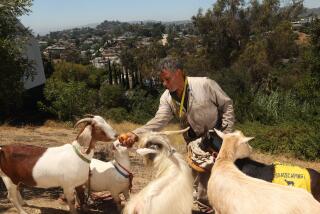60 Netted : Goat Rescue Opens on San Clemente Island
- Share via
An animal rights organization netted and corraled 60 goats on San Clemente Island Friday on the first day of a rescue operation aimed at bringing half the goats to the mainland for adoption.
Author Cleveland Amory, president of the New York-based Fund for Animals, said he was “very, very pleased” with the beginning of his group’s monthlong effort to save the goats from slaughter.
Planned to Shoot Them
The Navy had planned to shoot the 1,200 to 1,500 goats on the island, which serves as a Navy gunnery range, because the animals are jeopardizing the habitats of birds, plants and lizards on the island, which are protected by the U.S. Environmental Protection Act of 1973.
Animal rights activists, however, led by the Fund for Animals, decried the Navy’s solution to the problem and, earlier this month, Rep. Bobbi Fiedler (R-Northridge) persuaded Defense Secretary Caspar Weinberger to give the animal rights organization until March 4 to capture and relocate as many of the feral goats as possible.
Fiedler, who joined Amory for a press conference Friday at the Long Beach Airport, said she had “appealed to Cap Weinberger” for the reprieve because “the American people hate to see useless slaughter take place.”
Developed Capture Technique
Before boarding a helicopter to observe the operation on the island, located about 60 miles off the coast of San Diego, Amory said the group’s goal is to save 750 of the animals.
Fortunately for the goats, the “hunters” who dogged them relentlessly Friday had come to save them, not to kill them.
Bill Hales, who works for the Fund for Animals, helped develop the netting technique, in which a net is stuffed into a metal box with a pipe-like attachment that is joined to a sawed-off shotgun. When the gun is aimed at a goat and fired, it releases the net, which settles over and entangles the animal.
The Hughes 500 rescue helicopter used in the round-up, piloted by Mel Cain, had its back seats removed to accommodate about six goats at a time.
A Wild West atmosphere prevailed Friday morning as the rescue helicopter, followed by a posse of nine or so media helicopters, descended on the island to begin the capture operation.
As the bright blue rescue helicopter chased the goats, which traveled in groups of three or more, the media helicopters chased the rescue helicopter.
Small herds of warthogs grazed nearby, unmolested.
The goats, frightened but fleet-footed, ran in zigzag patterns as they headed for the shrub-covered gullies or the sheer, rocky cliffs of the island in attempts to escape.
Some did elude the hunters temporarily, heading cannily toward hard-to-reach areas such as cliffs or deep ravines that run to the ocean.
But most of the goats seemed to realize that it was time to surrender. Appearing dazed and confused, their pace eventually slackened, their pattern of movement grew less erratic, and, usually with a single quick, expert shot, Hales would fire the net over them from the hovering helicopter, capturing as many as five at a time.
Once in custody, the goats became surprisingly docile, allowing Hales and Cain to remove them from the nets, tie them up, and load them onto the helicopter for removal to a restricted area at the northwest tip of the island.
Hales and Cain seemed to have no problem spotting the goats, which blended in deceptively with the rugged terrain
The Navy, which uses the island most of the year for bombing and shelling practice, announced earlier this year that the animals would be shot from a low-flying helicopter.
Amory called Friday’s round-up of 60 goats an “all-time record” for one day, in reference to past efforts by animal rights groups. A rescue operation last summer netted a total of 600.
Amory said that “from the look of things, if we can continue to get very high numbers during the early days of the operation, before the animals get skittish or wary, we should have good success” in meeting a goal of saving half the animals.
The goats removed for the island will be transported to four holding areas in California to await adoption, with charges of $25 for the billys and $35 for the nannys. The phone number for adopting a goat locally is 818-789-1190.
The Navy plans to slaughter the goats that are left.
-------------------------------------------------------------------------- Times staff writers Gordon Grant and Mark I. Pinsky contributed to this story.
--------------------------------------------------------------------------
More to Read
Sign up for Essential California
The most important California stories and recommendations in your inbox every morning.
You may occasionally receive promotional content from the Los Angeles Times.













